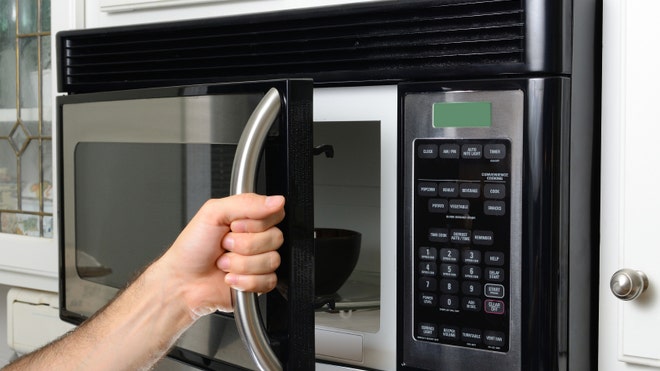
Microwave ovens became a common feature of Australian kitchens around the same time as lime green benchtops and burnt orange stoneware.
But while modern microwaves have shed the wood veneer panelling, some people still have concerns about food safety.
So what happens when you nuke your food in a microwave oven? Well, for a start you’re not nuking it: you’re actually heating it with low frequency electromagnetic energy, the energy is lower than light, another form of electromagnetic energy, says Bob Steele from Food Science Australia.
Microwaves penetrate more deeply than light, and heat food by rapidly vibrating water molecules. When a microwave oven is turned off, there are no microwaves left behind in either the oven or the food.
Unlike ionising radiation from nuclear energy, low frequency electromagnetic energy (microwave ovens use a frequency of around 2,450 Mhz) has “little or no ability to break strong chemical bonds,” Steele says.
For this reason, there is not any substantiated evidence it causes undue chemical changes in food and creates toxins, he says.
But what about nutrition? The majority of research suggests microwave cooking is just as nutritious as other methods and may have some benefits.
“In general, because you are able to heat food much more rapidly, retention of vitamins is higher,” Steele says. And nutrient retention, especially for the water soluble vitamins B and C, is better than other cooking methods such as boiling where the water soluble vitamins are often thrown out with the water.
In fact, microwave heating has been used to improve extraction of nutrients from foods. Work at CSIRO has shown better bio-accessability of anti-oxidants in microwave heated foods.
As foods cooked in microwaves don’t brown, microwave cooking also helps to retain amino acids such as lysine, he says.
Microwave warnings
There are, however, some things you should watch out for.
One of these is the use of non-approved plastics to hold hot food. The main concern is that some plastics, such as those used as yoghurt containers, can melt, potentially resulting in serious burns, says Steele.
Non-food approved plastics should never be used. Look for containers with the international food-safe symbol (see pic below). While, in the past there has been some concern with non-food approved plastics like PVC contaminating food, this is unlikely to happen with food-approved plastics that are clearly marked with the words “microwave safe”.
These plastics are designed to withstand high temperatures. However, even these can fail in a microwave oven, so never heat cooking oil in plastic containers as the temperatures can easily exceed the melting point of the plastic and potentially cause serious burns.
Uneven heating can be another major problem – not only can it allow the growth of micro-organisms, it can also cause scalding.
Domestic microwave ovens should never be used to sterilise foods. Low temperatures and uneven heating mean you can not be guaranteed that pathogenic spores have been inactivated, he explains.
Safety tips
Steele’s top tips for safe microwave cooking are:
- always read the instructions on the packet
- never reheat food more than two minutes (because of the risk of scalds)
- never heat fats or cooking oils in a microwave oven – the temperatures can easily become excessive and may melt even the most resistant plastic container
- always allow one to two minutes standing time to allow heat to even out
- always use plastics approved for food use in a microwave oven. These are marked with the international food contact symbol (see left) and the phrase ‘microwave safe’.
- always be careful – use a glove to remove the container from the oven.
- And while independent testing of microwaves indicates that radiation leakage is uncommon for new models, older models could be a health hazard if the door is damaged or doesn’t fit properly.
So even though retro is back, it might be time for that old microwave to go.
Source: abc news

